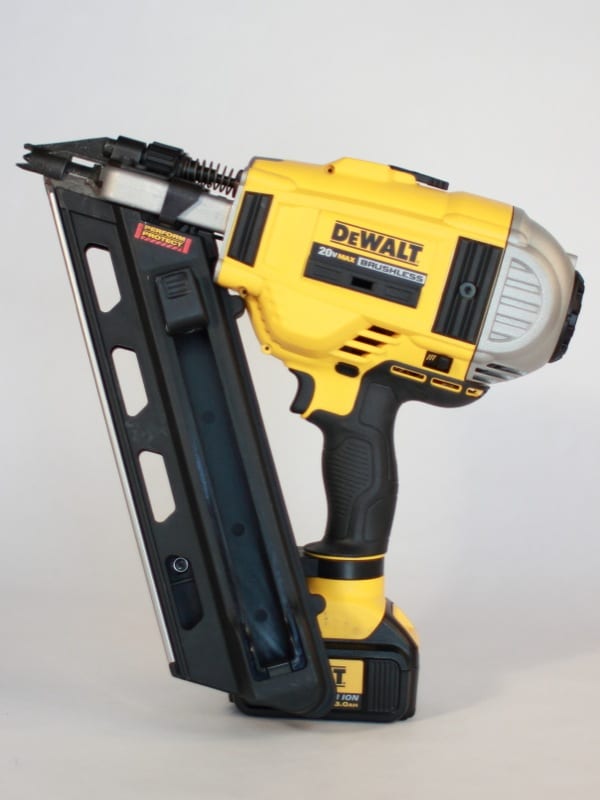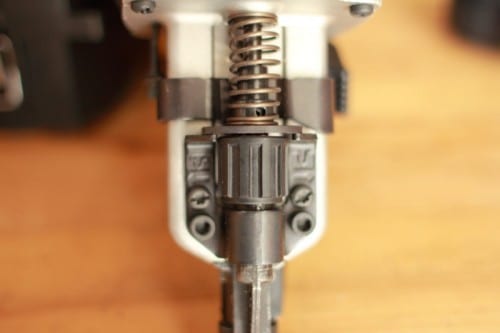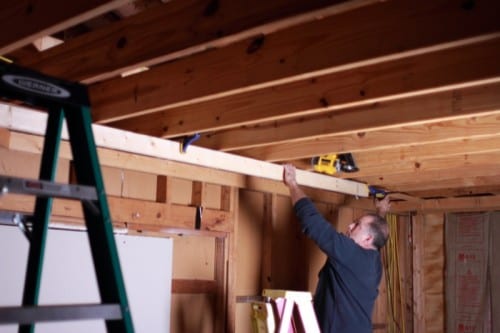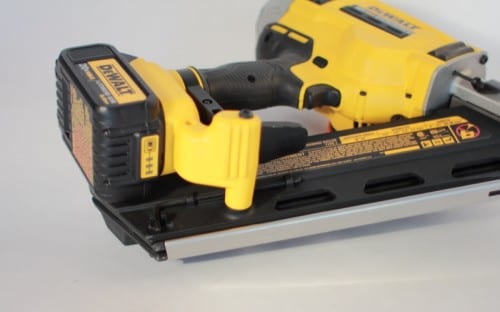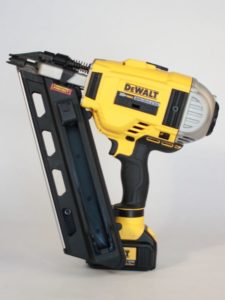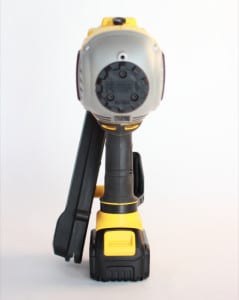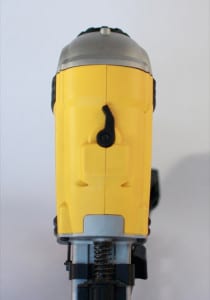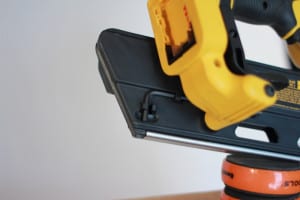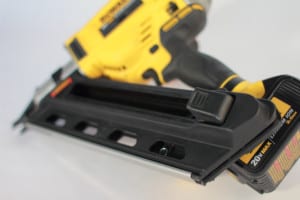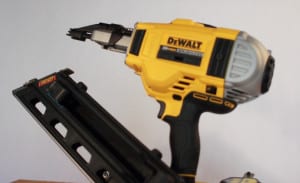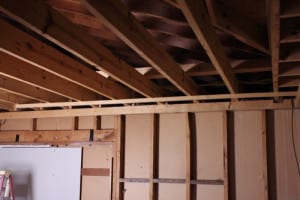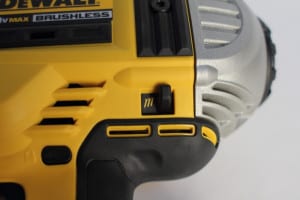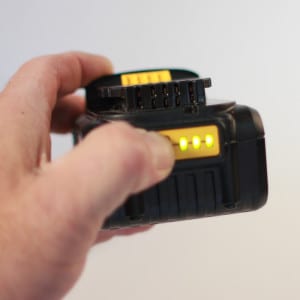I’ve always had a soft spot in my heart for cordless nail guns—nailers, as the manufacturer’s lawyers prefer them to be called. Almost 20 years ago, I was working as a producer for a show on HGTV and had several segments in mind that required the host to nail things. About that time I saw a magazine ad for Paslode’s Impulse finish nailer and I had an epiphany—that would save time on re-takes on a television show, wouldn’t it? I got one. Naturally, every time I pick up a cordless nailer, I’m now inclined to compare it with my first love. That’s dangerous—not only with relationships but with power tools as well. No one ever lives up to that kind of pressure, but at least you know my baseline when it comes to reviewing the DeWalt DCN690 Cordless Framing Nailer.
Editor’s Note: Check out our updated DeWalt 20V Max Framing Nailer review.
DeWalt DCN690 Cordless Framing Nailer
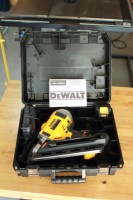
As I continued to inspect the tool and read the directions (I felt compelled to before actually reviewing it), I became even more skeptical of its abilities.
“To avoid double fires: Use Sequential action trigger.”
Does DeWalt know something I should know before using it? I mean, doesn’t that defeat the whole purpose of “bump firing”?
“Cold weather operation: keep the tool as warm as possible prior to use.”
“Hot weather operation: Tool should operate normally. However, keep the tool out of direct sunlight as excessive heat can deteriorate bumpers and other rubber parts…”
Seriously? How many job sites do you know of that are air-conditioned to a comfy 72 degrees with low humidity? Most are usually one extreme or the other. But here again, I was in for a bit of a surprise. I think it’s a safe bet that all the rules listed in the manual were crafted by corporate attorneys. (Call it a hunch.)
Lights, Camera, Action
It was time for the DeWalt’s big debut on the job. I used it for a remodeling project that, on my current schedule, should be completed in the next 20 years. It’s a combination den/media room upstairs in my 60 year old house. I’m adding a soffet around the perimeter of the room, and the DeWalt was my trusty construction partner.
Testing DeWalt DCN690 Cordless Framing Nailer for Max Power and Capacity
At first, I went for the maximum allowed fastener length, which is 3-½”. What I should have done was taken into account the ambient air temperature in the room (about 54 degrees and no humidity) before being so ambitious. As an added challenge, I left the protective nose-piece on the tool—totally unnecessary, as this wasn’t trim work, but I liked the test.
Maybe not my brightest idea (Notice, I blamed myself, not the tool?), as the nailer left the fasteners about a half an inch proud. It did this repeatedly, so I decided to back off on the bully tactics, as you’ll see in a minute. This was also when I got to test the worthiness of the Stall Release Lever. Again, that oddly satisfying thwip inspired confidence, as the blade slid back to its home.
At this point, I decided to quit the bully tactics and did three things:
- Emptied the tool and loaded 3” nails into the magazine.
- Removed the protective nose-piece.
- Set up my cordless propane-fired Mr. Heater and warmed the room up a bit.
Testing Bump-fire Mode
After a few minutes, I went back to work—success! The tool drove the fasteners deeply into the wood fibers without so much as a whimper. And yes, those 3’s are plenty of fastener for the project. I then calmly turned my attention to the sequential/bump fire switch and slid it defiantly into place, ignoring those strongly-worded manual warnings. What can I say, I’m a rebel and wanted to be a first-hand witness to those legendary double-fires I had been warned about.
This is about the time I got my big surprise. I stood on the ladder, positioned my safety glasses just so, spotted my target, and went in for the kill.
Whoa…this tool loves bump-firing! Who knew? To be honest (Never say that in court, by the way, it implies that everything you’ve said previously was a lie.), I felt the tool worked much more smoothly in this mode than in sequential. It’s just my opinion, but remember, I’ve had a love affair with these beasts for a long time and have seen them come and go. Anyone remember the Senco Evolution? I was there, and the memories are still fresh.
The 20V Compromise
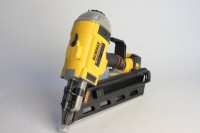
The DeWalt DCN690 Cordless Framing Nailer has that tell-tale, albeit momentary, delay between trigger pull and nail firing. It’s simply the nature of the beast. The tool has to develop the power, inertia—whatever you want to call it—to drive a steel rod into wood fibers, at the basic level. That’s where the delay comes in, and that’s why the fuel/spark nailers tend to be a bit faster.
I like the new DeWalt new DCN690 nailer, especially in sequential mode. I think the reason for the superior performance in that mode could be the fact that you’re already starting the downward force when you push on the nose each time. You naturally apply more force when bump-firing than you do otherwise. It becomes second nature and almost instinct to do so, after awhile.
Conclusion
With that being said, I think this tool may be best suited for the remodeler, as opposed to the custom-builder. It will do well in the hands of its owner—someone who has shelled out hard-earned money to purchase the tool and wants to make sure it lasts a good long while. After all, we all know how “community tools” get treated. I think they’re somewhere below rental cars and skis on the food chain.
I would imagine the tool will under-go refinements in the months, years, and decades to come. They all do, every year it seems. That may seem optimistic, but I think this nailer has a bright future. The bones are there and so are the basic features. The designers and engineers who worked on it should be proud of their baby—just take care to nurture it kindly into adulthood. I’m looking forward to the birthday cake next year.
Buy Now at Acme ToolsFeatures
Cordless Power:
The DeWalt DCN690 Cordless Framing Nailer operates on DeWalt’s 20V Max batteries. I like the fuel gauge, and the charging time is reasonable. It does,of course, vary, depending on ambient air and battery temperature, so let’s just leave it at that. It’s a very respectable power plant, and it’s driving a brushless motor system that maximizes the energy to the striking mechanism.
Sequential/Bump Fire Mode Switch:
The switch is in a reasonably convenient location and operates smoothly—not too easy and not too hard to move. The trigger lock is also conveniently located and easy to operate.
Fastener Magazine:
This is where it starts to get interesting. The magazine is offset just a smidgen, possibly due to the motor and battery assembly. This could contribute slightly to the balance issue I mentioned earlier. Loading fasteners is a breeze. The Pusher Latch locks into “loading position”, so you’re not fighting it as you load nails into the mag. It snaps nicely into “firing position” when pressed. No complaints here.
Rafter/Belt Hook:
The hook leaves a bit to be desired. According to the manual, the hook can be easily adjusted to either side of the tool to accommodate left or right-handed users.
I found the two best positions were:
- Opposite the magazine and
- Completely stowed under the handle.The other positions seemed pretty worthless to me. There wasn’t enough clearance around the tool to hang the nailer on your belt, let alone a rafter.
Depth Adjustment Wheel:
It operates as advertised and is pretty smooth. I found that I simply dialed it into “halfway to China mode” to sink the nails well into 2x material.
Stall Release Lever:
As strange as it seems, I got excited when I got to use this feature. That’s good and bad for DeWalt. When the plunger lodges in the down position, you simply turn this lever, and you can feel the blade slide back into firing position. Weirdly satisfying.
Clearing A Jammed Nail:
Does this technically qualify as a feature? It does if you ever have to use it. The good news is, I didn’t have to this time. Just for kicks, though, I went through the motions. My only complaint: I abhor mechanisms that require the use of an additional tool (I,e,,the infamous hex key). In my experience, they’re never where you left them and certainly nowhere to be found when you need them. To their credit, DeWalt created on-board storage for the little rascal—I just hope that it never has to stray far from its home.

